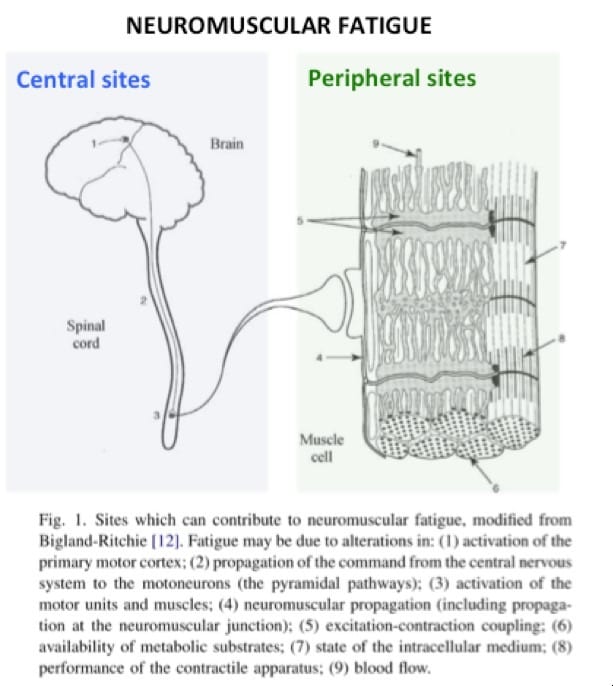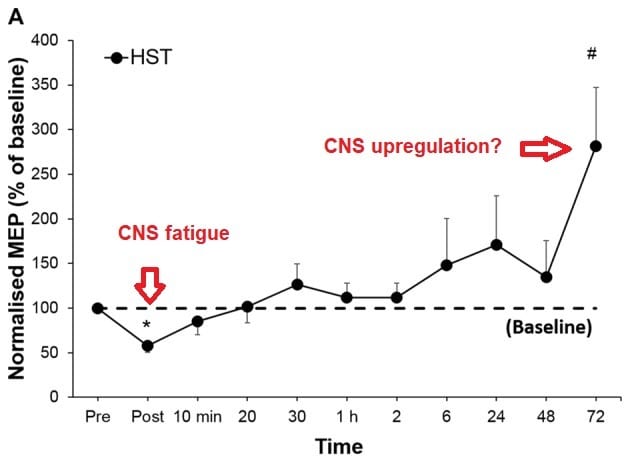Workout That is Easy on the Cns
You know how squats and deadlifts tire you out so much?
Why it takes days to recover after a heavy squat or deadlift workout?
How you have trouble sleeping after a heavy workout?
Why compound and high intensity exercise are more fatiguing than isolation work and higher rep sets?
That's central nervous system (CNS) fatigue… supposedly. CNS fatigue is a topic riddled with broscience. Many people invoking CNS fatigue in their arguments can't even explain what it is. Let's start there.
What is CNS fatigue?
As the name suggests, CNS fatigue occurs in the central nervous system: the brain and the spinal cord. If your CNS is fatigued, it has trouble activating your muscles. So even while your muscles are capable of producing a lot of force, they may not achieve this potential, because the CNS isn't giving them the proper instructions. More formally, central fatigue occurs when the excitation supplied by the motor cortex and/or motoneuron activity decreases. In other words, CNS fatigue is a decrease in voluntary muscle activation.
CNS fatigue is distinguished from peripheral fatigue, which occurs outside the CNS. Muscle damage and metabolic stress within your muscles are an example of peripheral fatigue. Their effects are local and specific to the muscle in which they occur. If you tear a hamstring, that won't inherently affect your quadriceps. In contrast, CNS fatigue can affect your entire body.

Myth 1: The higher the exercise intensity, the more CNS fatigue you induce
CNS fatigue is commonly said to occur from exercise with large neural demands, namely high intensity exercise. So the theory is that low reps induce more CNS fatigue than high reps. It sounds very plausible. The higher the training intensity, the CNS activation is required, the more fatigued the CNS gets, right?
Wrong. It's completely the other way around. Low intensity, high duration exercise causes far more central fatigue than short, high intensity exercise [2, 3, 4].
CNS fatigue is readily observed after endurance exercise, like marathons, but scientists often really have to go out of their way to reliably induce central nervous system fatigue with strength training. As an example of a 'strength training' study that found significant central fatigue, Smith et al. (2007) studied a 70-minute biceps contraction. I don't know about you, but that's not how I train my guns. A similar study found central fatigue after a 4-minute dorsiflexor contraction.
A more realistic training design compared 3 sets of 12 with 1 minute rest in between sets vs. 5 sets of 3 with 3 minutes rest in between sets. Which caused more CNS fatigue? Trick question. Neither workout caused any CNS fatigue. Other research has also failed to find CNS fatigue during resistance training regardless of the intensity used.
In fact, in both of these studies there was upregulation of central motor output, presumably to offset the peripheral fatigue. So not only was all the fatigue peripheral, the CNS was actually working overtime to compensate for the local fatigue.
You may object that most of this research was in weak individuals performing isolation exercises. How about some guys and ladies that actually lift heavy iron? We've got the perfect study on this. Howatson et al. (2016) studied the neuromuscular recovery of elite athletes. The guys were were squatting well over 8 plates (190 kg) and running the 100 m in 10.44 seconds. For reference, the world record is 9.58 seconds, set by Usain Bolt in 2009. The ladies were rocking an over 4 plate squat (108 kg) and running the 100 m in 11.73 seconds. The world record is 10.49 seconds, set by Florence Griffith-Joyner in 1988 (ludicrously ahead of her time). These elite athletes then performed one of their typical workouts, consisting of 4 sets of 5 reps for the back squat, the split squat and the push press: a total of 12 sets of heavy compound work. Split squats are a strong contender for the most brutal exercise in strength training. Push presses involve the entire human kinetic chain from feet to hands and involve more musculature than squats or deadlifts. Even in this case there was no central fatigue. Voluntary central nervous system activation did not decrease from pre- to post-workout and was still stable 24 hours later. Of course, there was significant neuromuscular fatigue, as evidenced by reduced contraction power of the muscles (MVIC) and an insignificant trend for lower jump height (CMJ). There was also metabolic stress, as measured by an increase in blood lactate. But the nervous system had no trouble activating the muscles. The muscles were simply fatigued themselves, presumably from the damage of the workout and the metabolic stress. The fatigue was local, within the muscles, not in the central nervous system.
If you think about it, it makes sense that the central nervous system doesn't easily fatigue. Muscle fatigue is easy to imagine: it can occur mechanically. Muscle fibers can literally tear from the tension of hard contractions. For the CNS many people speak of 'neural fatigue'. How does that work? The CNS is more similar to a computer than a muscle. A computer doesn't fatigue with use. Sure, it can overheat and over the years it can become slower, but it doesn't fatigue acutely. It doesn't become slower and slower if you use it for a long time in one sitting. So how would the CNS fatigue? Some researchers have questioned whether CNS fatigue exists at all. The vast majority of what was previously thought to be central fatigue can actually be explained by local fatigue. However, as we've shown above, central nervous system fatigue is real. CNS 'fatigue' probably occurs via other mechanisms. For example, it may be neurochemical: due to the effects of neurotransmitters. Or it may be metabolic: muscular ammonia production during exercise can leak into the blood and cross the blood-brain barrier, causing neurotoxicity [2, 3]. In any case, high activation of the brain's motor cortex by itself doesn't cause CNS fatigue, so low reps do not cause more CNS fatigue than higher reps.
Myth 2: The more compounded the exercise, the more CNS fatigue it causes
Conventional bro wisdom is that deadlifts are the bane of the CNS. Heavy deadlifts cause so much CNS fatigue that you can only do them once every so often or you'll overtrain. Next up are squats, then most other compound exercises. Isolation exercises don't cause CNS fatigue.
Science says:

The heavy push press, squat and split squat workout above didn't induce CNS fatigue. Yet several of the studies that did find CNS fatigue used leg extensions or biceps curls. So clearly isolation exercises can cause CNS fatigue and compound exercises do not necessarily cause it. How about a direct comparison in the same study though?
Barnes et al. (2017) directly studied the claim that deadlifts cause more CNS fatigue than squats. They had trained men perform 8 sets of 2 reps at 95% of 1RM with 5 minutes of rest in between sets in the squat and deadlift on separate occasions. These heavy-duty powerlifting workouts indeed resulted in central fatigue, though not all that much: a 5-10% reduction in central neural output. In spite of the higher weights used, greater amount of musculature involved in and greater total work performed during the deadlifts, the deadlifts did not result in more central fatigue than the squats. There was also no significant difference in testosterone or cortisol production.
In conclusion, the research does not show any relation between the amount of musculature involved in an exercise and the amount of CNS fatigue it induces. Isolation exercises can cause CNS fatigue and compound exercises do not always do. If there is any relation at all, it's certainly not nearly as strong as commonly claimed. This comes back to the CNS being more like a computer than a muscle: harder tasks do not necessarily fatigue it more.
Myth 3: CNS fatigue takes longer to recover from than muscular fatigue
You commonly hear the saying that while your muscles may be recovering in between workouts, your CNS may not. Over time this accumulation of fatigue could result in overtraining. Cool theory, but let's see some data.
Latella et al. (2016) studied the time-course of CNS recovery after strength training. They managed to induce a whopping 46% decrease in corticospinal excitability (measured by motor-evoked potential). This means major CNS fatigue. How many days do you think it took for the CNS to recover?
It took 20 minutes for the CNS to recover. There was already no more significant loss of MEP after 10 minutes. Other research confirms that CNS fatigue is only evident directly post-workout even though muscle soreness and peripheral neuromuscular fatigue took over 3 days to recover from. This probably explains the lack of CNS fatigue in the elite athletes study we discussed earlier: Howatson et al. measured CNS fatigue 10 minutes post-workout. That may have already been too late. Interestingly, Latella et al. also found evidence that there was upregulation of the CNS rather than fatigue in the days after the workout: see the graph below. MEP = motor-evoked potential, which is roughly the strength of the signal sent by the motor cortex to the exercised muscle. A decrease suggests that the CNS can no longer fully activate the muscle, i.e. CNS fatigue.

All other measures of central fatigue in Latella et al's study (ICF, LICI and SICI) showed no impairments at any point during the studied 72-hour recovery period. Even directly post-workout they were unaffected. So only certain aspects of CNS functioning seem to be susceptible to fatigue.
In conclusion, CNS fatigue is largely acute. It normally doesn't take days for the CNS to recover. The CNS can recover within minutes.
Source: https://mennohenselmans.com/cns-fatigue/
0 Response to "Workout That is Easy on the Cns"
Post a Comment